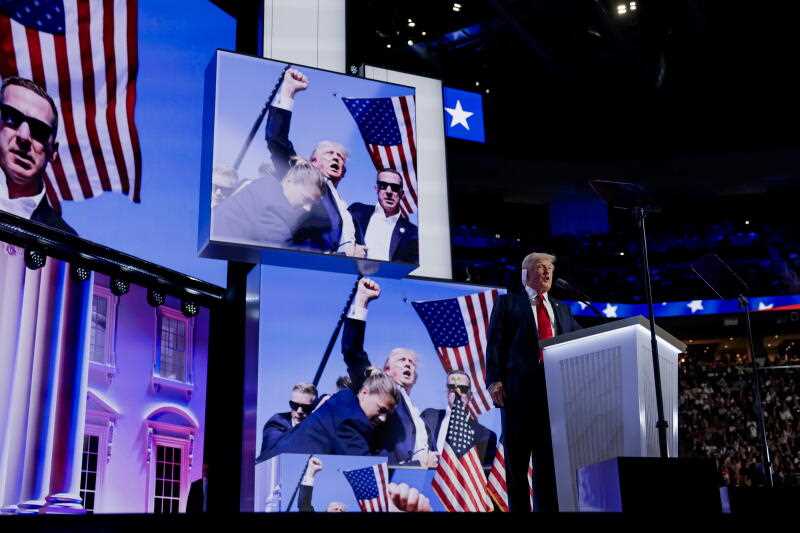Jo Dyer
How Joe Biden can save the world

Perhaps it’s our 24-hour media cycle but apart from fake bandages adorning ears at the Republican National Convention, the attempted assassination of Donald Trump seems already to be fading as a political story, replaced by the apotheosis of the reinvention of J.D. Vance and the latest round of “Where’s Melania?” Not entirely, of course. The bullet that grazed Trump came surprisingly close to killing him given his would-be assassin had been rejected from the varsity rifle team as a dangerously bad shot. Former intelligence officers put it down to Crooks’ choice of gun – the AR-15-style rifle, a forgiving yet powerful weapon for the inexperienced or nervous. Accessible too, of course, and that, along with the cautious approach the Secret Service apparently take to sloped roofs, helped a nerdy high school graduate bring a nation within two centimetres of catastrophe.
Everyone except Kyle Gass stifled bad-taste jokes, a courtesy Trump did not extend to Paul Pelosi, and watched Republicans take to social media to blame Biden for the febrile environment their candidate so assiduously fomented.
The Republicans are crowing. Their man is the resurrected Messiah while the Democrats have Casper the Friendly Ghost. These post-assassination-attempt liminal moments seem a good time for a grand gesture from Joe: an announcement to the country and the terrified world looking on that he recognises his nation needs change. That in an America so dangerously divided, old leaders should make way for new, and that he, Joe Biden, is calling time on an incendiary battle with Trump to allow the country to step back from the abyss. Their time has passed. In one deft generous move, Biden not only neutralises the issue that risks his party the election, he weaponises it. He secures his legacy and his dignity and a Democratic White House by wrongfooting his overconfident, also aged opponent.
Trump’s near-death experience doesn’t change the fact that his election would be calamitous. He was never fit for high office – any office. His cruel and chaotic first term proved it. The rabid right come carefully prepared for a second term with Project 2025 and the consequences are unthinkable. There is still time to avoid them. With the stakes this high, the Democrats did us all a disservice by covering up the extent of Biden’s senescence. We’ve seen the most youthful of leaders age swiftly in the Presidency: it’s no surprise a 78-year-old was taxed.
Biden should have kept the commitment he made in the 2020 primaries and been an avowed one-term president – a transitional figure to calm the nation after the dark discord of the Trump Presidency. But Trump refused to play his part and, instead of disappearing back to a Mar-a-Lago sun lounge, stayed prominent, launched a coup, then a comeback, and chaos threatens to engulf America again, this time with an emboldened, vengeful, newly immune President Trump and a corrupt Supreme Court enabling him.
Joe Biden, like so many American leaders before him, refuses to accept the reality of old age. Dianne Feinstein insisted on shuffling into the Senate after her daughter had assumed power-of-attorney. The cost of Ruth Bader Ginsberg hanging on was all she was warned it would be. Joe Biden remains convinced he is the best person to defeat Donald Trump. “I’ve done it before!”, he insists breathily, as if that wasn’t four years ago, when he was spry.
It is not too late to turn this around. Let the Republicans finish their jamboree with its motley collection of freaks, Trumps and grifters, and then pull the carpet from underneath them with a dignified press conference from Biden calling time on an unprecedented career of service and welcoming a new era in politics.
With Biden out of the race, the hopefuls will put up their hands. Harris – surely the favourite. Whitmer. Newsom. Buttigieg’s been invisible but might enter the fray. Warnock a possibility but spoken more of as a potential running mate for Whitmer, with astronaut-turned-Senator and husband of Gabrielle Gifford Mark Kelly a good option for Harris. The candidates must then marshal support from the 3936 delegates eligible to vote at the Democratic Convention in August. To Australians, this seems normal. If you want the leadership, you do the numbers. You try and line up the votes. The campaign for the nomination could include a series of mini debates between those most likely, as James Carville has suggested. These could be televised. Debate kept civil. A showcase for the Democrats’ impressive depth of talent. The contrast will be obvious. At the end of the process, the Democrats can elect a candidate in Chicago who can project optimism and energy, integrity and competence, and above all change – a candidate the party can unify behind and support all the way to the White House.
A late leadership change can transform a race. Australia had one in 1983, when Bob Hawke seized the leadership of the Australian Labor Party from the hapless Bill Hayden in a bloodless coup on February 8, 1983, wrongfooting Prime Minister Malcolm Fraser, who had asked the Governor General to dissolve parliament and call an election for March 11 only minutes before. Hawke romped it in. Jacinda Ardern in New Zealand only became the leader of their Labor Party on August 1, 2017. Her dynamic new energy secured a large swing to her party in an election less than two months later, the momentum she generated allowing her to successfully negotiate with minor parties to form a Coalition Government. She won Government in her own right three years later. Australia and New Zealand are smaller countries, of course, with different electoral systems but, as Paul Keating said to Bill Clinton of their respective economies at an APEC meeting, “You’ve just got a few more zeroes, mate”. You may need more votes to win an American election, but votes are there to be won.
As a long-term member of the Democratic Party’s Rule Committee and author of the book Primary Politics: How Presidential Candidates Have Shaped the Modern Nominating System Elaine Kamarck said on the ABC’s Planet America this week, “You cannot beat someone with no-one”. As demonstrated by Tony Abbott’s empty chair reprieve in 2015, a leadership contest requires two contestants. In theory anyone can nominate to be the Democrats’ presidential candidate at their August convention. But if anyone wants to beat Biden in a head-to-head vote on the convention floor, they’d have to be manically obsessively doing the numbers right now, potentially first to secure a simple majority to change Rule 11(H), the so-called Robot Rule that binds delegates to vote for the candidate they were elected to support although only “in all good conscience”, and then to persuade them to defect to an alternative candidate in the substantive vote. No-one is. None of the viable alternatives to Biden have shown any signs that they’ll take him on, whether because of loyalty, fear or cowardice. Let’s hope they’re involved in urgent conversations behind the scenes that persuade Biden to finally accept what everyone else has known for some time. Biden must stand down.






